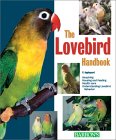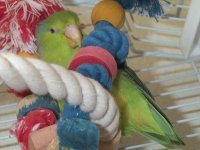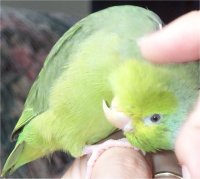The Mighty Parrotlet
The diminutive parrots of the genus Forpus often have a fiesty, courageous nature that belies their small size. The beak is quite large for such a tiny bird, giving them a somewhat unusual appearance. Many people refer to parrotlets as “amazons in a pint-sized body.” They truly do not seem to realize they are about the size of a parakeet.
The most popular pet species of parrotlet are the Pacific, Mexican, and green-rumped. Many claim that the green-rumped parrotlets have the most gentle nature of the three. Although some say that the males make better pets, I have known people who were very happy with their little parrotlet hens. Most species of parrotlet are sexually dimorphic, meaning there are some visual differences between males and females that allow you to distinguish between them.
If you are interested in a parrotlet as a pet, it is best to get a hand-fed, well-socialized bird. Parrotlets can develop nippiness if this is not discouraged from a young age. This means don’t allow even gentle nibbling of your ear lobes, skin, or fingers. This gentle nibbling can turn to a rather unpleasant bite when the bird matures.
Parrotlets have a nice little chirp that a friend once remarked to me, “Reminds you of the rainforest.” The sound is rarely offensive so this bird is an excellent choice if you live in an apartment or are otherwise worried about noise. They have the potential to speak, although their voices are very quiet. Owners often don’t even realize the bird is trying to mimic them unless they really listen in a quiet room.
Parrotlets tend to be very active and playful. They enjoy a variety of interesting toys they can swing and hang from. Their active nature means they need a stimulating environment so they don’t become bored. Many parrotlets will happily plan on a little gym outside the cage. However, remember that they are very small and should be supervised at all times when out of the cage. Because of their playful nature, it is best to get them a cage that is large enough for their antics. A parakeet-sized cage might seem right for their size, but it is better to take a step up to a lovebird or cockatiel size cage.
My personal experience has been with green-rumped parrotlets. They make very affectionate, sweet pets but they are ultimately quite fearless. Their fearless nature can get these tiny birds into a heap of trouble if they are not properly supervised at all times. I remember receiving a number of e-mails from owners who thought it was funny when their parrotlet chased another pet, such as a cat, dog, or larger parrot, off the couch or play area. This is very risky behavior to encourage because parrotlets can be very easily injured by a larger bird or other animal they might try to challenge.
Parrotlets truly are like amazons in a miniature body. They can be quite willful. Therefore, it is important to socialize and train them the exact same way you would a larger parrot such as an amazon. Teach the “up” command from the beginning and use it at all times. Remove the bird from its cage rather than let it wander out on its own, again using the up command.
One of the best things about parrotlets is that their personality is so like larger parrots yet they are easy to house, never terribly noisy, and while if they do bite you will definitely feel it, they can’t do the kind of damage a large amazon could. These feisty little birds can make wonderful pets and are often quite willing to be handled by all family members as well as visitors. Just remember that proper handling and consistent socialization and training keeps these birds happy and well-adjusted as pets.
For more on parrotlets, visit the Parrotlet Species Guide
The photo of the female Pacific Parrotlet, Mini, was submitted by Manon Roos.











